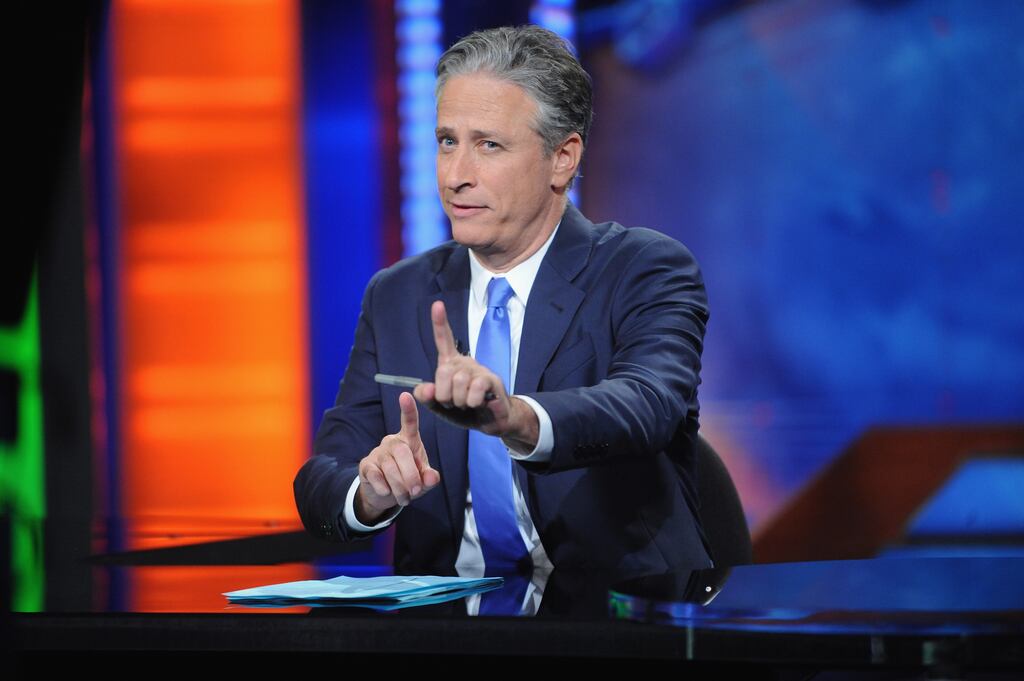News that Jon Stewart is returning to late-night television in the US will elicit a nostalgic sigh from American viewers of a certain vintage, along with a smaller cohort on this side of the Atlantic who recall with fondness the heyday of The Daily Show on Comedy Central during the George W Bush years, when Stewart’s takedowns of Fox News and the perfidies of neocons offered a window into his country’s political id that was unavailable elsewhere in those pre-podcast, pre-viral clip, pre-streaming days.
Stewart will only be hosting the show once a week, but is his return wise? He demonstrated a keen sense of timing when he stepped down in 2015. It meant not only that he didn’t have to ply his trade during the beyond-parody dumpster fire of the first Maga White House but also that he left just before the end of the United States’ late-night-comedy boom. It’s not his fault, but ratings have been collapsing at an alarming rate ever since. “The Daily Show cable audience has declined by 75 per cent, from 2.2 million to 570,000 viewers a night, while its viewers’ median age, which was 48 in the mid-2010s, is now 63,” Rolling Stone observed last week.
“Holy crap, look how small and old the Daily Show’s audience has gotten,” Business Insider echoed more pithily in one of a slew of think-pieces using the news of the return to reflect on the precipitous decline of the genre to which Stewart is now attempting a Norma Desmond-style return. Stewart’s former Daily Show proteges Stephen Colbert and John Oliver are doing a little better, but the direction of travel is clear. You all know the reasons: the death of linear television that is happening everywhere is accentuated in the US by “cord-cutters” who refuse to pay the exorbitant fees charged by cable companies.
[ Jon Stewart’s Daily Show: 16 years thinking outside the boxOpens in new window ]
What, then, is the rationale for bringing the 61-year-old back into the ring? It appears it may be something even grander than saving late-night comedy. It could in fact be (drum roll, please) the small matter of saving the United States and democracy itself.
READ MORE
Announcing the news, the chief executive of Showtime/MTV Entertainment Studios, Chris McCarthy, described Stewart as the “voice of our generation” who will “help us all make sense of the insanity and division roiling the country as we enter the election season”.
We can take it as given that the “our generation” in question is the one that bridges baby boomers and Generation X. What’s rather more queasiness-inducing is the notion that, like some old retired gunslinger persuaded to take on one last job, Stewart has been convinced to get back on air to “make sense” of things and, by thinly veiled implication, run a certain orange-skinned New York huckster out of town.
Already in Democratic-tilting circles you can hear earnest suggestions that Stewart can help to turn the tide that suggests a Trump victory in November. Despite the fact that nobody watches the show any more, everyone will see the clips, apparently.
This is self-delusion on a dizzying scale. One is reminded of the late Peter Cook, who famously described the Establishment, his comedic satire club, as dedicated to all those 1930s Berlin cabarets that “did so much to prevent the rise of Adolf Hitler”.
The genre of television that Jon Stewart pioneered took the newly available base metal provided by 24-hour news channels and turned it into comedy gold. But over the years his ilk became more like preachers to the converted
The hubris doesn’t stop there, as some political opponents have already gleefully pointed out. “Jon Stewart hasn’t been funny since the Iraq War,” American Conservative asserted. To be fair, he was pretty funny then, but the point stands: if it doesn’t make you laugh, why bother? Stewart and his successors have always steadfastly stuck to the line that they were comedians and not journalists. The genre of television that he pioneered around the time of Y2K and 9/11 took the newly available base metal provided by 24-hour news channels and turned it into comedy gold, skewering the absurdities of the right-wing establishment and the hypocrisies of Christian conservatives.
But over the years he and his ilk became more like preachers delivering earnest homilies to the converted. And they fell victim to the creeping self-censorship of the progressive left. Where they started off by saying unsayable things that people were delighted to hear, they ended up saying predictable stuff that everyone had heard before.
Who, then, are Stewart’s real successors for a new generation? An unsettling answer is proposed in an essay by Jon Askonas that picks apart the role the left-wing satire boom played in undermining the strait-laced impartiality of old-style network TV, and the contribution that made to the fragmented, hyperpartisan American media of today.
“As he tore down the pillars of the phony old consensus reality, he was laying the foundation for authentically fanatic alternate realities,” Askonas writes.
In this telling, Stewart’s true successor wasn’t Stephen Colbert or John Oliver or Samantha Bee. It’s none other than his old foe, race-baiting Putin pal Tucker Carlson.
















